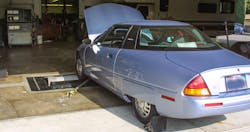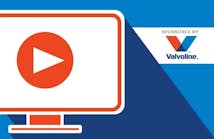For those who have been in the service industry since the mid-‘90s, most of us have witnessed quite a remarkable evolution of alternative propulsion systems. Twenty years ago, the Toyota Prius was the first mass-produced hybrid vehicle to hit the North American market. Sales of the Prius continue today, and several other hybrid models have entered the mix.
My shop is in Southern California, and we’ve been servicing hybrids for many years. For the most part, many of their service items aren’t much different than that of internal combustion engine (ICE) vehicles. Tires, suspensions, and axles all wear the same and require maintenance and repair. Brakes don’t typically wear out as fast due to regenerative braking. However, these braking systems still require periodic maintenance, which is often overlooked. Brake caliper sliders, for instance, can bind or seize up due to minimal use, especially if the vehicle operates in a harsh environment where there’s a lot of moisture or snow.
Hybrids, extended range, and battery electric vehicles require a different protocol of service attention. Many have thermal management systems tasked with maintaining optimal temperatures for the batteries and power management systems. This means that the heating, ventilation, and air-conditioning (HVAC) systems are increasingly becoming critical components and will need to operate properly to enable proper vehicle operation. All these vehicles will likely continue to support a low voltage system backed by a sound, 12V battery.
Service knowledge
When it comes to high voltage systems, a working knowledge of how they operate can keep you safe and healthy. However, your front office staff’s familiarity with these alternative propulsion system vehicles will likely need an upgrade as well.
Being able to intelligently communicate with hybrid/EV customers is key to gaining their trust and subsequent business. If you’re thinking about working with electrified vehicles, I suggest getting up to speed first with the essentials, such as gauging your market and learning more about what it takes to provide competent services in this market.
It’s important to seek out and use the correct tooling, as well. The proper category rated (CAT) equipment as defined by the International Electrotechnical Commission (IEC) 61010 standard should be top of mind when choosing the proper tooling and equipment for work on hybrid and electric vehicles. The CAT ratings are in place to define how much voltage the tool can tolerate without causing any damage or harm.
There are many places one can acquire technical knowledge. One option is to join a hybrid franchise group or similar organizations focused exclusively on electrified vehicles.
Toyota
Since the Prius is one of the most popular hybrids on the market, it’s worth looking at how accessible service information, training, and diagnostics are for Toyota/Lexus vehicles in general.
On Toyota’s service information site, one can subscribe at the standard level for as little as $20 and for two days would have access to technical service bulletins, repair manuals, wiring diagrams, technical training, and more. Think about how much intelligence you could gain for that investment.
However, if you’re new to the Toyota Technical Information System (TIS) you’ll probably also benefit from knowing that you can subscribe at the professional level. With a certified J-2534 interface, you get access to Toyota’s Techstream Lite diagnostic scan tool interface. This program also includes module programming capabilities, and if you’re interested in accessing security functions on Toyota and Lexus vehicles, you can visit NASTF.org and apply for a Vehicle Security Professional credential. Once you have that, you can subscribe to Toyota’s Security Professional level.
Tesla
Tesla is an interesting company and one that many traditional OEM’s are watching closely. Accessing training and tooling for Tesla vehicles is nearly impossible, but one can start studying up on these vehicles through other means, as there are entities out there that are starting to pool resources and knowledge and develop service solutions for Tesla customers who are no longer interested in visiting their closed network.
From my experience, if you want to see what the future of vehicle transportation looks and feels like, drive a Tesla. If you own a Tesla, be forewarned that one of the experiences you’ll have difficulty witnessing is how the vehicle’s features and operation improves through software updates.
As a Tesla owner myself, I’ve noticed all the updates my vehicle has received thus far never required a visit to a service department. This is because Tesla takes advantage of their connected vehicle network and is able to deliver updates and receive vehicle feedback over-the-air (OTA).
Many manufacturers are beginning to take advantage of OTA updates, and I believe this shift will continue to grow as manufacturers race towards the autonomous drive vehicle. The sheer amount of data the vehicle can collect while in operation is essential in supporting tomorrow’s advanced self-drive vehicles.
As far as Tesla product knowledge goes, one can gain a ton of intelligence by simply spending time online reading about the manufacturer. Rich’s Rebuilds is one source for good information. This guy purchases wrecked Teslas and either rebuilding them or transplants propulsion systems into other vehicles. Quite a bit of service knowledge can be obtained by watching his expansive video library.
Jack Rickard with EVTV Motor Werks is another resource to consider. Rickard is an engineer and an electric vehicle junkie. He may have some resources that can help you get up to speed as you broaden your horizons with electric vehicles.
Certification and standards
In the United States, unfortunately, there are little to no requirements or standards for those working on electrified vehicles. However, in other countries such as Germany, you’re required to become a high voltage expert before you can provide any service on an electrified vehicle.
I am fortunate to be participating in a project focusing on a certification standard for those working on high voltage vehicles. This is a four-year project funded through the National Science Foundation (NSF) and is in its final year. The folks participating in these efforts are some of the most intelligent individuals with real-world working experience I have ever met.
I am proud to be part of this effort and love to learn from these great colleagues. If you’re interested in learning more about this grant, you’ll find that information by searching “NSF 1700708”.
Culture
The electric vehicle owner is typically a little more in-tune with their car than the average driver and in-fact, some are highly knowledgeable. I’ve had the pleasure of meeting hundreds of hybrid/EV owners over the years and early on, I realized that when talking to these folks, they know a lot more about their vehicles than most.
Several I’ve interacted with are highly intelligible and often possessed degrees in electrical and or mechanical engineering. Even more reason to have your staff knowledge and experience levels in order if you’re looking to secure your spot in providing professional services on electrified vehicles.
Getting up to speed
There are regionally based online forums where consumers of these electrified vehicles communicate. Tuning into some of these might be beneficial in surfacing many of the common complaints, and symptoms these various carlines are exhibiting. I’ve participated in many, and it’s amazing to see some of the stuff taking place in the market even at the OEM level. I’ve seen horror stories describing the repeated trips to the manufacturer dealership to get problems resolved.
I am in no way trying to disrespect the OEMs and their service dealer network, as there are a lot of cases out there where these folks are on the front lines, and they are seeing failure modes for the first time. Oftentimes, the OEMs have poor test plans or documentation within their service information. As you can see, there can be great benefit achieved by virtually living through these experiences.
Moreover, the demand placed on today’s technician is very high, and these technicians will disappear into other industries if they’re not provided with the proper tools and knowledge to thrive in this environment.
Case study
In 2012, I purchased a 2013 Chevrolet Volt and still own the vehicle today. It’s been fairly trouble-free through its first 105,000 miles of operation, but I did have an interesting issue very early on. Within the first 7,000 miles or so I began to experience a dead zone with the electric power steering (EPS) system.
My symptom was that when the vehicle was in its warm up period (0-10 minutes) and I was on the freeway at 50-70 mph, I found that the EPS was unresponsive to minor corrections with steering input and I had to apply a lot more torque to the wheel in order to get the steering to react. As any technician would, I began to closely monitor this behavior and was quickly able to establish a pattern where I was able to duplicate the condition.
I was hesitant to take it to the dealer since I frankly didn’t have much faith that they would be able to address the issue properly. Instead, I began searching the GM Volt forums for similar complaints and was pleased to find discussion on the subject. I then came across a GM employee who was tasked with sourcing vehicle operators with this complaint. I contacted this individual and provided my VIN. He connected me with a “Volt Liaison” who would provide communication support for the service dealer.
I wrote a detailed letter explaining how and when this problem occurred and how service personnel can increase their odds of duplicating the complaint. Armed with all that intel and my Volt liaison, I contacted my selling dealer and scheduled an appointment.
Five days after dropping off my vehicle I hadn’t received any information from the dealer, so I decided to call and place an inquiry. Prior to placing the call, I decided to look at my GM Volt phone app and noted the miles. The conversation quickly went to an update about how the service technician had driven the car numerous times and was unable to duplicate the complaint. I asked if the service technician was provided the information, I submitted that described the driving pattern. I was assured that he was and that they were doing everything they could to get the problem identified and solved.
I decided not to let the service advisor know that the mileage being reported through the app had not increased since dropping the vehicle off the previous Saturday. Instead, I mentioned this to the service manager on a later call and asked him to see what he could do to rectify the situation. The following day I received an update. A field engineer was out to look at the vehicle with the service technician and they concluded that the vehicle would need a new EPS rack and pinion. When I got off the call, I checked the app and to my delight I saw that the vehicle was driven nine miles.
A week later when I received a call stating that my vehicle was ready for pickup, I inquired about quality assurance and asked if the vehicle was aligned properly and road tested to verify proper operation. I was assured it was. As I drove away, I noticed that the steering wheel was no longer centered. The next day, I took the vehicle to my shop and returned the wheel to center. I never did hear back from the lengthy CSI feedback report I submitted as per their automated feedback system.
Conclusion
Today’s service technicians must continually advance their skillsets in order to stay ahead of the curve. I know quite a few very successful technicians who adopted early with hybrids vehicles. Their early discoveries are now paving the way to success in properly servicing and repairing today’s modern drivetrains, and I have no doubt that they’ll be ready for what tomorrow brings.



